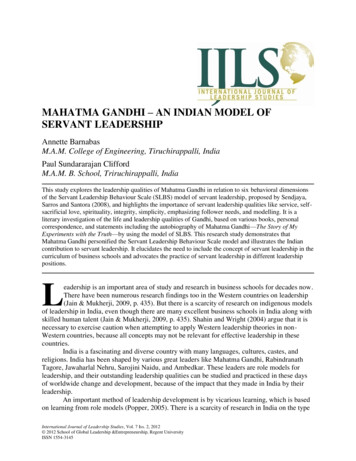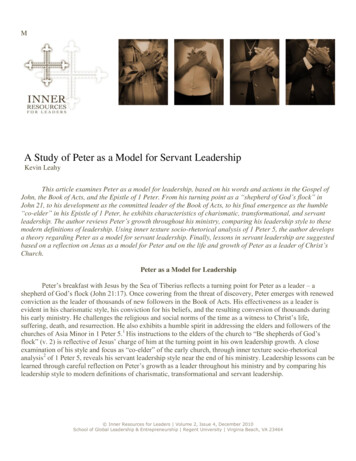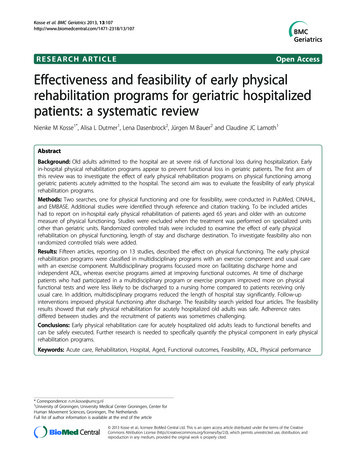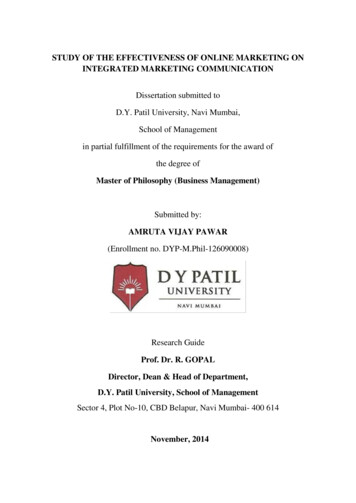
Transcription
Servant Leadership and the Effectiveness of TeamsSubmitted to Regent UniversitySchool of Leadership StudiesIn partial fulfillment of the requirementsfor the degree ofDoctor of Philosophy in Organizational LeadershipJustin A. IrvingMarch 2005
ii
iiiAbstractThe purpose of this study was to investigate the relationship between servant leadershipand the effectiveness of teams. While Greenleaf’s (1977) seminal work on servantleadership has led to a growing body of literature surrounding the construct, up to thispoint, very little has been done to investigate what effect servant leadership behaviorshave on the effectiveness of teams. In light of this void in the literature, the present studysought to answer the research question: “Is there a relationship between servantleadership and team effectiveness?” by conducting an empirical study in a U.S. divisionof an international nonprofit organization. The data collected were gathered using threeinstruments: (a) The Organizational Leadership Assessment (Laub, 1999); (b) TheServant Leadership Assessment Instrument (Dennis, 2004); and (c) The TeamEffectiveness Questionnaire (Larson & LaFasto, 2001). These instruments provided dataaround the following variables: (a) servant leadership at the organizational level; (b) jobsatisfaction at the individual participant level; (c) team effectiveness at the team level;and the servant leadership variables of (d) love, (e) empowerment, (f) vision, (g)humility, and (h) trust at the individual leader level. Pearson r correlation analyses wereused to examine the relationship between team effectiveness and the other variablesassociated with servant leadership and job satisfaction. A statistically significant andpositive correlation was found for each of the variables associated with servant leadershipand job satisfaction when analyzed in reference to team effectiveness.
ivDedicationTo the One who has transformed my life,The Divine Servant Leader—Jesus Christ.Have this attitude in yourselves which was also in Christ Jesus,who, although He existed in the form of God,did not regard equality with God a thing to be grasped,but emptied Himself,taking on the form of a bond-servant,and being made in the likeness of men.Being found in appearance as a man,He humbled Himself by becoming obedient to the point of death,even death on a cross.For this reason also,God highly exalted Him,and bestowed on Him the name which is above every name,so that at the name of Jesusevery knee will bow,of those who are in heaven and on earth and under the earth,and that every tongue will confessthat Jesus Christ is Lord,to the glory of God the Father.Philippians 2:5-11 (New American Standard Bible)
vAcknowledgementsI would like to offer special thanks to Dr. Winston for sharing his expertise andencouragement throughout my Ph.D. program and for helping to make this dissertationresearch both sound and significant. I also wish to express my gratitude to Dr. Laub andDr. Patterson for their work in serving alongside Dr. Winston on my dissertationcommittee. I have great appreciation for the work that each of these scholars have doneand am grateful for the insight that each have shared with me throughout this process.In addition to Dr. Winston and Dr. Patterson, both of whom serve in the Schoolfor Leadership Studies (SLS) at Regent University, I also wish to express my gratitude toDr. Klenke and Dr. Fields, both of whom provided an appropriate blend of challenge andencouragement as I developed my research skills, and to each of the remaining facultymembers in SLS. I am grateful for the commitment of SLS faculty to the development ofChristian leaders to change the world.I wish to offer my thanks to the host organization in which the research wasconducted and to those who graciously allowed their research instruments to be used inthis study: (a) Dr. Laub for the use of the Organizational Leadership Assessment, (b) Dr.Larson for the use of the Team Effectiveness Questionnaire, and (c) Dr. Dennis for theuse of the Servant Leadership Assessment Instrument.I would like to offer special thanks as well to the support systems andcommunities that have walked with me through this journey. First and foremost, I offermy public thanks to my precious wife and friend Tasha for her steadfast love andencouragement along this journey and to my children Abby, Hannah, and Caleb forbringing such joy to my life. Second, I am thankful for our friends at Immanuel who
viprovided a community of faith in which our family could be renewed and refreshed in theLord as the pressures of Ph.D. work were experienced. Finally, I am grateful for theencouragement and support of so many in the community at Bethel University. Amongthese, special thanks go to Dr. McCloskey for providing a vision for pursuing leadershipstudies in the first place, Scott Strand for his technical assistance with the web-based datacollection format used in the study, and Dr. Eliason and Dr. Bourgond who haveprovided a context in which my leadership and teaching could flourish.
viiTable of ContentsAbstract . iiiDedication . ivAcknowledgements. vDefinitions of Key Terms . xChapter 1 – Introduction . 1Statement of the Problem. 5Research Question and Hypotheses . 6Theoretical Support from the Literature . 7Instrumentation . 11Research Question and Hypotheses . 13Method: Design and Analysis. 15Scope and Limitations of the Study . 16Chapter 2 – Literature Review. 18Construct Development . 18The Development of Servant Leadership as a Construct. 18Servant Leadership in the Literature: Theoretical Investigations . 23Servant Leadership in the Literature: Empirical Investigations . 30Servant Leadership and Teams . 34Variables . 36Servant Leadership at the Organizational Level. 36Servant Leadership at the Individual Leader Level . 38Team Effectiveness. 41Instrumentation . 42The OLA (Laub, 1999) . 42The SLAI (Dennis, 2004) . 42The TEQ (Larson & LaFasto, 2001). 43Summary . 43Chapter 3 – Research Method. 46Hypotheses Associated with Servant Leadership at the Organizational Level. 46Necessary Data and Data Analyses. 47Associated Instrumentation. 47Hypotheses Associated with Servant Leadership at the Individual Leader Level. 49Necessary Data and Data Analyses. 50Associated Instrumentation. 51Hypotheses Associated with Job Satisfaction at the Individual Participant Level . 52Necessary Data and Data Analyses. 52Associated Instrumentation. 53Sample. 53Data Collection . 54Chapter 4 - Findings. 55Sample Characteristics. 55Data Collection . 56
viiiFindings Associated with Servant Leadership at the Organizational Level . 56Data and Data Analysis. 57Findings. 57Findings Associated with Servant Leadership at the Individual Leader Level . 58Data and Data Analysis. 60Findings. 60Findings Associated with Job Satisfaction at the Individual Participant Level. 62Data and Data Analysis. 63Findings. 63Alpha Coefficients for Research Scales. 64Chapter 5 - Discussion . 65Implications of the Findings . 65Implications of H1: Servant Leadership at the Organizational Level . 65Implications of H2 through H6: Servant Leadership at the Individual Leader Level 68Implication of H7: Job Satisfaction at the Individual Level. 72Comments on the Research. 74Recommendations for Future Research . 74Summary . 76References. 77
ixList of Tables and FiguresTable 1: Operational Themes of Servant Leadership . 3Table 2: OLA (Laub, 1999)-TEQ (Larson & LaFasto, 2001) Correlation Coefficients. 5Table 3: Servant Leadership Factors From Dennis' (2004) SLAI. 12Table 4: Matrix of Intercorrelations . 58Table 5: Servant Leadership at the Individual Level (SLAI; Dennis, 2004) and TeamEffectiveness at the Team Level (TEQ; Larson & LaFasto, 2001). 62Table 6: Alpha Coefficients for the Research Scales . 64Figure 1. Moderating Effect of Job Satisfaction. . 73
xDefinitions of Key Terms1. Leader: A leader is a person who is able to partner with followers in the creation andimplementation of a common vision.2. Followers: Followers are those individuals who voluntarily engage in the leadershipprocess by partnering with leaders and other followers for the purpose of achieving acommon vision.3. Leadership: Leadership is the process by which an individual or group influencesanother individual or group for the purpose of achieving a common vision.4. Servant Leadership: Servant leadership is a process of leaders and followerspartnering together for the purpose of achieving a common vision in which the goodof the led are placed over the good of the leaders.5. Team: A team is a partnership of two or more people who share a common objectiveor goal in which coordinated activity among the members of the team is requisite forthe attainment of the objective or goal.6. Effectiveness: Effectiveness is the attainment of common objectives or goals7. Team Effectiveness: Team effect
Effectiveness Questionnaire (Larson & LaFasto, 2001). These instruments provided data around the following variables: (a) servant leadership at the organizational level; (b) job satisfaction at the individual participant level; (c) team effectiveness at the team level; and the servant leadership variables of (d) love, (e) empowerment, (f) vision, (g) humility, and (h) trust at the individual .











